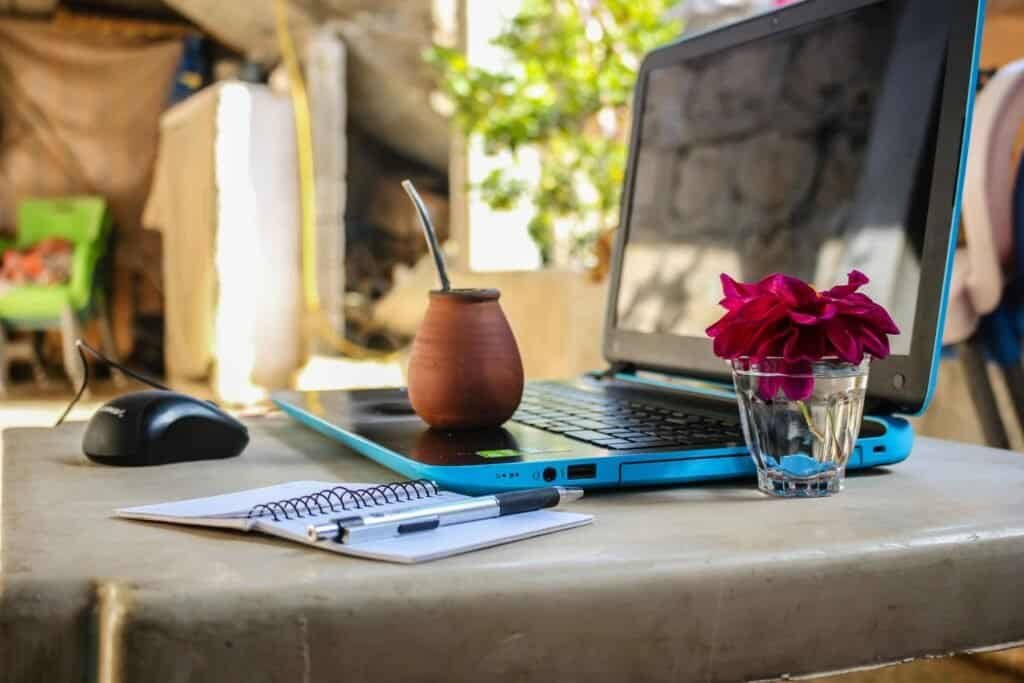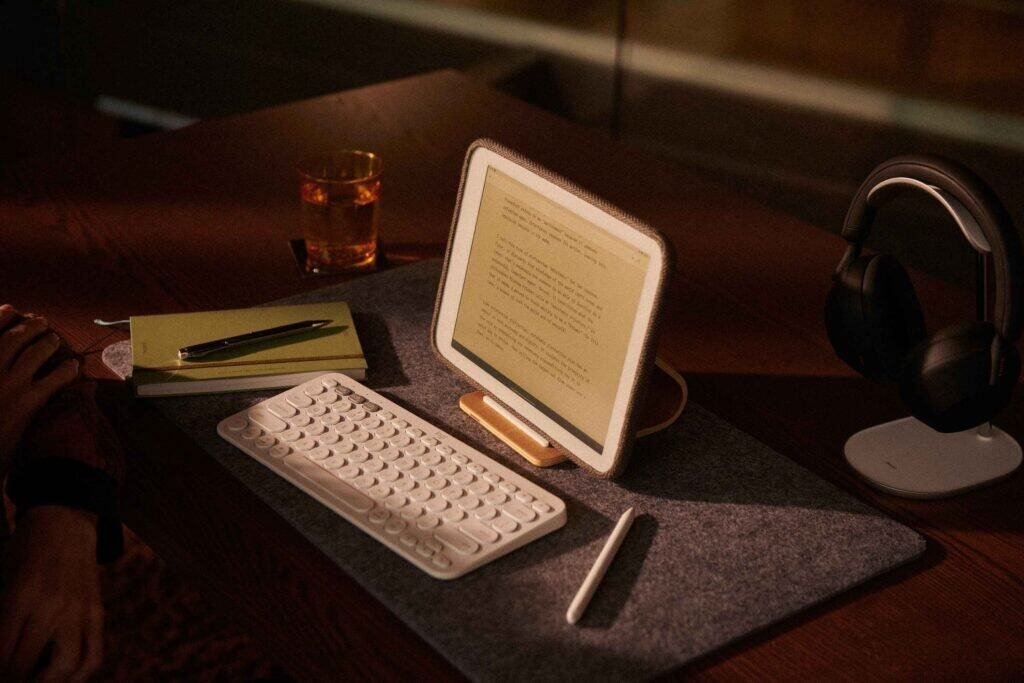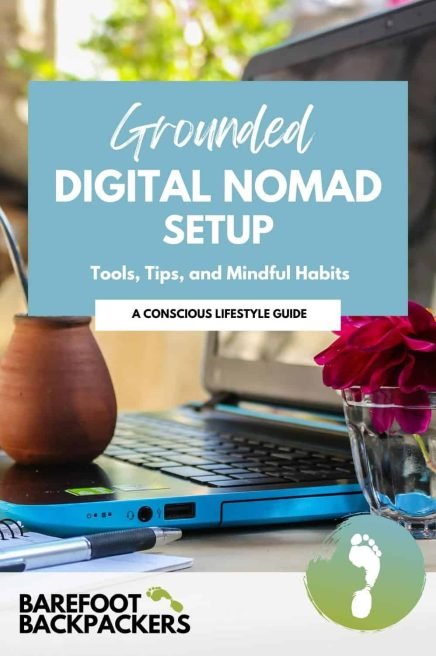Remote work is more than a way to earn a living; it is an opportunity to thrive anywhere. A grounded digital nomad setup supports productivity, mental clarity, and overall well-being. When work is approached mindfully, the body stays energized, the mind remains focused, and the natural rhythm of work and life continues to flow, even in the midst of constant travel.
Yet long hours on screens, blue light exposure, and the strain of sitting for extended periods often leave digital nomads depleted. These challenges are real, but they are not inevitable. With a grounded routine and a few carefully chosen essentials, it is possible to protect energy, sharpen focus, and create a workspace that nurtures both creativity and well-being.

This blog is supported by the community. We may earn a small commission if you choose to purchase through our links, which allows us to keep creating content. As an Amazon Associate, we earn from qualifying purchases. Learn more.
Building Your Grounded Digital Nomad Setup
The foundation of any digital nomad setup begins with good posture. Hours spent looking down at a laptop place unnecessary strain on the neck and spine. Each degree the head tilts forward adds significant weight, creating pressure that builds slowly and often goes unnoticed until energy is depleted and focus is lost. A grounded workspace supports the body as much as the mind.
One of the simplest and most valuable tools is a collapsible laptop stand. They are lightweight and raise the screen to eye level, helping the body remain in an upright position.
Pair it with a wired keyboard and mouse, which will give you more distance from the screen and will reduce EMF exposure compared to Bluetooth devices.
For sound, whether on calls, listening to music, or using binaural beats to deepen focus, wired headphones are a simple and reliable choice to reduce emf exposure. Each of these small, intentional choices shapes a workspace where energy feels preserved and concentration flows naturally.
Protecting Your Eyes
Screens are central to remote work, yet their glow can be draining. The concentrated blue light exposure often leave the eyes tired and the mind unsettled. With a few mindful adjustments, screen time does not need to strain the body. By softening the glow and protecting your vision, you can work with screens more consciously.
One simple practice is to pause regularly and shift your gaze into the distance. Looking towards the horizon helps balance the eyes after periods of close focus. Blinking is also reduced dramatically when looking at screens, so being mindful of consciously blinking and taking short breaks gives the eyes much-needed relief.
Natural sunlight is one of the most powerful tools for protecting vision. Working outdoors, or simply near a bright window, allows sunlight to regulate circadian rhythm and restore energy throughout the day.
E-Ink displays like the Daylight computer, reflect ambient light rather than emitting harsh blue light, make it possible to work comfortably even under direct sun.
Any prolonged work with screens, it is important to protect the eyes. Clear blue-light-filtering glasses are useful during the day, filtering out the harshest frequencies while keeping screen colors natural.
As the sun sets, switching to red-tinted lenses helps block artificial light completely. These small shifts protect circadian rhythm, prevent sleep disruption, and keep the body in balance. With conscious choices like these, digital nomads can maintain focus through the day and enjoy deeper rest at night.

Additional Tools for a Grounded Digital Nomad Setup
A few extra essentials can make a big difference to a digital nomad setup. These tools help protect devices, maintain connectivity, and keep work flowing smoothly.
1. International adaptor – one of the most versatile pieces of gear, ideal for charging smaller devices like phones and travel cameras.
2. Grounded travel adaptor – safeguards against surges while reducing stray electricity. If you’ve ever felt a small shock or buzzing when touching your laptop, it’s likely because most standard adaptors use plastic grounding prongs, leaving the connection ungrounded.
3. Multi-port dongle – a compact tool that accommodates USB and Ethernet connections, reducing the need for multiple adaptors.
4. Flat Ethernet cable for faster, more stable internet when needed.
5. 4K webcam – a valuable upgrade if your laptop’s built-in camera doesn’t deliver clear video.
Insurance for Peace of Mind
Having flexible travel insurance is a good idea for any digital nomad. While it may not be as visible as your laptop, it provides a layer of security that allows you to focus on work and travel without worry.
A suitable policy can cover health emergencies, lost or damaged belongings, and unexpected travel changes. This reduces stress and helps you stay productive and calm while on the move. For those who move between countries frequently, a policy that adapts to different locations and durations works best.
One popular option among digital nomads is SafetyWing, designed with travelers and remote workers in mind. It offers flexible coverage that can adjust to your lifestyle, making it easy to stay protected no matter where you are. Even basic coverage can make a noticeable difference, giving you peace of mind so you can enjoy the journey fully.
Integrating Work and Life
Life as a digital nomad is a chance to integrate work, travel, and well-being in a way that feels natural and sustainable. By creating a grounded workspace, protecting energy, and adding tools that support your flow, each day is an opportunity to focus on work and enjoy life. With mindful habits and simple choices, remote work blends seamlessly into the rhythm of travel, leaving more space for freedom, creativity, and the joy of the journey.








